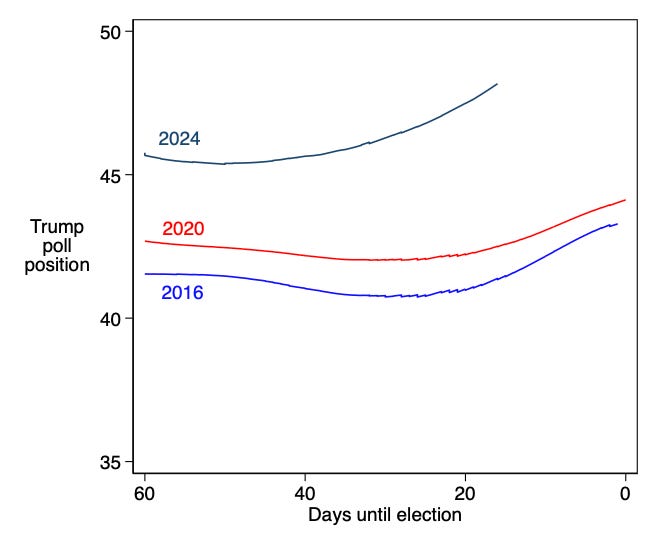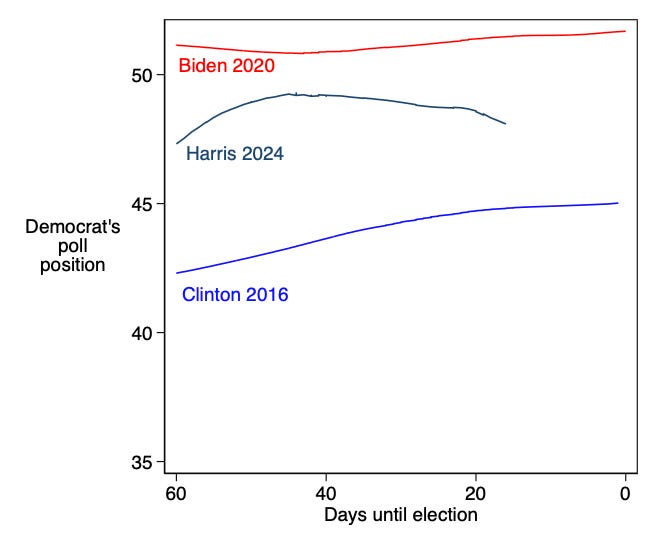A lot of recent punditry has focused on what a weird election year this is, how much uncertainty there is in the polling, etc. But in a number of ways, what stands out about this election is how familiar it is. Donald Trump and his supporters are doing much of what they’ve done in the previous two election cycles.
Trump is in a very small club of people who have been major party presidential nominees three times. The last person to do this was Richard Nixon, who last stood for election 52 years ago. But there’s a very familiar pattern to Trump’s support in the lead up to an election. In the figure below, I have taken a lowess moving average of Trump’s support in all of the national presidential polls compiled by FiveThirtyEight in the final 60 days of the 2016, 2020, and 2024 presidential elections.1
There are a number of important reasons why directly comparing the overall levels of support across years is inappropriate. For example, there was a larger third party vote in 2016, and a number of pollsters have sought to make adjustments in 2024 to capture Trump supporters they missed in previous cycles. But to me, the levels of support are less important than the overall shape of the moving averages. In each of these cases, Trump’s support rose by several points in the final weeks of the election.
Each time this happens, it seems to catch political observers by surprise. In 2016, for example, Trump’s rise in support came right on the heels of the Access Hollywood tape reveal in which Trump bragged about sexual assault. In 2020, his rise followed his spectacularly bad debate performance and his own diagnosis with Covid. In 2024, his numbers are going up even as his campaign makes arguments that are either explicitly racist, deeply anti-democratic, or promising of violence, or uses his rallies to sway to multiple versions of “Ave Maria.” Oh and it seems to have dropped out of the news but he’s a convicted felon awaiting sentencing next month.
Many political science studies have identified a pattern in which presidential campaigns largely serve to bring party supporters home; the relentless campaigning and advertising reminds people about what they like about the party they grew up in and what they dislike about the other party, which is why we tend to see third party support wane in the final months of a campaign. Trump has benefitted from this pattern. Even as many Republican voters have expressed concern about things he says, the way he tweets, etc., they tend to find themselves hating Democrats far more, and Democratic campaign attacks focusing on things that voters find problematic about Trump do not seem to erode his support very much in the end.
For what it’s worth, here’s what the last three Democratic candidates’ support patterns have looked like. Biden’s support was essentially flat in the final months of the campaign. Harris’ was initially rising but is now off about a point from her high last month. Clinton, interestingly, was on the rise in the final months as support for third party candidates waned.
The suggestion here is that Democrats had already “come home” in 2020 and 2024 before Labor Day and hadn’t been scared off by their presidential nominee’s statements and behavior, while Hillary Clinton was steadily earning her party’s trust after a divisive nomination cycle. The patterns for the three nominees are notably different from each other.
Trump’s patterns, however, are remarkably consistent. He makes a valiant effort to drive supporters away through the use of divisive rhetoric and unpalatable behavior, but in the closing days of the campaign, enough Republicans afraid of Democratic rule make peace with this to put Trump within striking distance of, if not a majority of the vote, an Electoral College win.
One could, of course, refine this by limiting the analysis to polling houses above a certain rating, or those just involving two candidates, etc. This is admittedly a “dumb” average but still captures the movement of the polls.







Well, that’s depressing.
Thanks, Professor! Coincidentally, later that day my Substack subscriptions all stopped arriving, which I just noticed earlier today. Now I'm going into the app direct and just saw this. As a confirmed nervous D I'm probably wired to see doom in those charts.